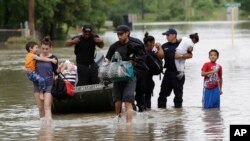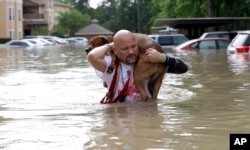A group of west Houston residents filed a lawsuit May 25 against the city over commercial development projects they allege were approved without requiring measures to deal with storm water. Their complaint goes to the heart of the question about what constitutes a natural disaster and what constitutes a disaster resulting from failure to plan and prepare for natural occurrences.
Around the world, many cities are located on seashores, lake fronts or on the banks of rivers for commercial transportation purposes. But as sea levels rise and storms grow more intense, crowded urban areas will be vulnerable to disasters.
The more than $70-billion cost of Hurricane Sandy, which struck the northeastern U.S. coast in October, 2012, came from damage to homes, buildings and the infrastructure that serves the region’s dense population.
Houston is one of the least-dense cities in the world, but U.S. Census figures show the city and its surrounding area is the fastest-growing urban center in the United States. While that provides an economic boost, it also brings more roadways and buildings near rivers and creeks that drain into the Gulf of Mexico.
Samuel Brody, a professor at Texas A&M University, says this contributes to the flood risk.
“We tracked, over a 15-year period, a 25-percent increase in impervious surface coverage, pavement, in the Houston region. And that translates into more people and structures in harm’s way, and less opportunity for rain water to infiltrate into the soil, and then it runs off, potentially into people’s homes,” said Brody.
Greater risk
Because of its rapid growth, Houston is becoming a bigger target, but its location has always made it vulnerable, according to Francisco Sanchez of the Houston Office of Emergency Management.
“One of the challenges is where we chose to build Houston, which is essentially on a swamp and it is also close to the gulf coast,” he said.
Sanchez noted, however, that many parts of the city and surrounding areas did not suffer much damage in last month’s storms. He said lower areas hit with unusually strong downpours were those that sustained the most damage.
“The flood plain is an indicator that you could be susceptible to flooding, but what we have seen over the past few flooding incidents is that anytime you get a significant amount of rain in a condensed period of time over a very specific geographic area, that is where we are going to see some flooding,” said Sanchez.
Protective action
Coastal drainage experts like Texas A&M’s Brody say government officials on all levels need to start considering future risks related to climate change. Climate studies show an increased likelihood of strong storms, as well as a rise in sea levels that will put populated coastal areas at risk.
Numerous scientific research studies project that in low-lying, heavily populated coastal areas in Asia, Africa and South America, storms and large waves could threaten millions of lives in coming decades, though even better off and better protected cities also could face expensive disruptions.
Hurricane Sandy’s cost to the U.S. economy was largely due to widespread power outages and the closing of tunnels leading into New York City, where the financial district went dark.
In 2008, Hurricane Ike caused traffic jams and power outages over a large part of southeast Texas, interrupting the operations of some oil and gas companies for several days. People in Houston spent hours lined up at any gas station that had fuel to offer, and supermarkets and stores lost millions of dollars in sales because shipments were not arriving, and there was no electricity to operate lights, computers and other essential parts of the modern retail system.
But the more immediate problem in cities like Houston is the vulnerability of houses built in areas that could flood more often than previous studies had indicated. Many homes are built in what is called a 100-year flood plain, which basically means the likelihood of flooding is about one percent every year. Some of those areas flooded last year and again this year, however, leaving home owners less confident in their protection from water damage.
Brody favors a long-range plan to take many houses out of such areas and to protect others by building them higher.
“We are going to have to think about elevating existing structures or new structures or building adaptively where we can abandon lower floors and add upper floors, which is being done in other countries,” Brody said. “We need to be more adaptive and flexible to changing environmental conditions.”
The Executive Director of the Harris County Flood Control District, Mike Talbot, says such suggestions are nothing new.
“That has actually been the criteria for the past three decades, that homes are built above the 100-year flood level,” he said. “The Flood Control District and FEMA (Federal Emergency Management Agency) have acquired more than 3,000 homes that are hopelessly deep in the flood plain and relocated people to higher ground and now that is open space.”
Crucial planning
Another problem facing officials in this large, sprawling urban area is the large number of jurisdictions. In addition to the city of Houston, there are more than 30 separate municipalities, along with hundreds of subdivisions, many of which have their own rules. Talbot emphasizes the Flood Control District works with all of them.
“I think one of the good things we have is an agency like ours, the Flood Control District, that overlays the entire county,” he said. “So, we work closely with all the municipalities. There is really a harmony between our design criteria that works together very well.”
Despite all these efforts, however, experts say lives will still be at risk if ordinary citizens fail to understand flood risks. They say people buying homes need to inform themselves about flood risks, buy the proper insurance and plan ahead for emergencies.
Additionally, Talbot says the public needs to appreciate the danger posed by rapidly rising water. He notes that none of the people who died in the recent floods were at home; they all died because they were out in the storm and, in some cases, drove right into flooded streets and underpasses.








